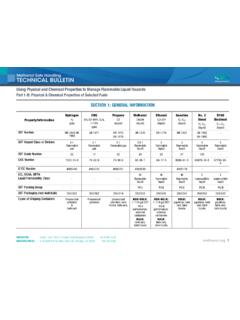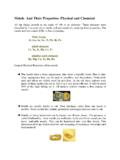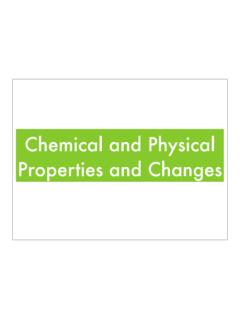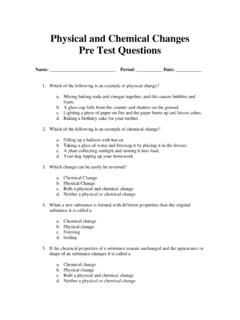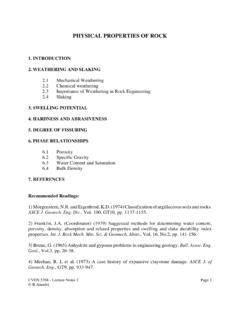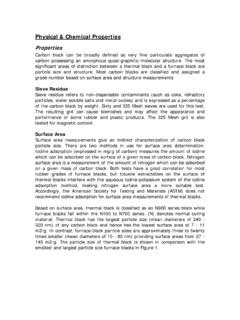Transcription of Alkanes Physical and Chemical Properties - …
1 AlkanesPhysical and Chemical PropertiesAttractive Forces Acting Between Ions & Molecules Secondary Forces Pure Electrostatic Attractions - chiefly ionic compoundsDipole-dipole attractions - chiefly between molecules + + + + + + + +Dispersion Forces - Very weak, due to a temporary shift in electron distribution dependent on the size of the moleculeAttractive Forces Acting Between Ions & MoleculesPhysical Properties of AlkanesAlkanes are Nonpolar Only dispersion forces act between Alkanes are insoluble in points, melting points, and densities generally increase with the size of the alkane: Decane > Heptane > ButanePhysical Properties of CCH3CH3-89CH3(CH2)3CH336CH3(CH2)7CH3151C H3(CH2)11CH3235CH3(CH2)16CH3316 Physical Properties of AlkanesBoiling points generally decrease with increased branching as a result of decreased surface area.
2 Consider C9H20CH3CH2CH2CH2CH2CH2CH2CH2CH3H3C CHCH2CH2CH2 CHCH3CH3CH3H3 CCCH3CH3CH2 CCH3CH3CH3 Physical Properties of Alkanes3-D Structures of Isomeric Nonanesn-nonane, bp 151 C2,6-dimethylheptane, bp 135 C2,2,4,4-tetramethylpentane, bp 122 CPhysical Properties of AlkanesThe Basis for Fractional DistillationHot crude oil is fed in at the foot of the fractionating column and mixed with steam. Various constituents, or fractions, of the crude oil separate at various points of the column.# C s1-471316192225+ Physical Properties of AlkanesThe Basis for Fractional DistillationPhysical Properties of AlkanesComparison of Boiling Points for Alkanes and CCH3CH3-89CH3-OH65CH3(CH2)3CH336CH3(CH2) 3-OH118CH3(CH2)7CH3151CH3(CH2)7-OH194CH3 (CH2)11CH3235CH3(CH2)11-OH255CH3(CH2)16C H3316CH3(CH2)16-OH308 Note.
3 All organic molecules may have Alkane-like portions of their structures which confer hydrocarbon-like Properties on the moleculesBoiling involves breakdown of dispersion forces + polar involves breakdown of dispersion forcesPhysical Properties of AlkanesComparison of the Boiling of Ethane (a hydrocarbon) and Methanol (an alcohol)methanol, bp +65 Cethane, bp -89 CBoiling involves breakdown of dispersion forcesBoiling involves breakdown of dispersion forces + polar Properties of AlkanesComparison of the Boiling of a Hydrocarbon and an AlcoholLiquid GasLiquid GasHowever, the boiling points are very ?? Physical Properties of AlkanesComparison of Boiling Points for Alkanes and CCH3CH3-89CH3-OH65CH3(CH2)3CH336CH3(CH2) 3-OH118CH3(CH2)7CH3151CH3(CH2)7-OH194CH3 (CH2)11CH3235CH3(CH2)11-OH255CH3(CH2)16C H3316CH3(CH2)16-OH308 Note: All organic molecules may have Alkane-like portions of their structures which confer hydrocarbon-like Properties on the moleculesChemical Reactions of AlkanesChemical Reactions of AlkanesCombustion - Burning in Oxygen Propane burns in oxygen to yield carbon dioxide and water.
4 C3H8 + O2 ---------------> CO2 + H2O Propane burns in oxygen to yield carbon dioxide and water. Propane burns in oxygen to yield carbon dioxide and water. C3H8 + O2 ---------------> CO2 + H2O C3H8 + ? O2 ---------------> 3 CO2 + 4 H2O C3H8 + 5 O2 ---------------> 3 CO2 + 4 H2 OChemical Reactions of Alkanes Butane burns in oxygen to yield carbon dioxide and water. C4H10 + O2 ---------------> CO2 + H2O Butane burns in oxygen to yield carbon dioxide and water. Butane burns in oxygen to yield carbon dioxide and water. C4H10 + O2 ---------------> CO2 + H2O C4H10 + ? O2 ---------------> 4 CO2 + 5 H2O 2 C4H10 + ?
5 O2 ---------------> 8 CO2 + 10 H2O 2 C4H10 + 13 O2 ---------------> 8 CO2 + 10 H2 OCombustion - Burning in OxygenChemical Reactions of AlkanesHalogenation - Reaction with Halogen + UV light Methane reacts with chlorine gas in the presence of ultraviolet light to yield chloromethane and hydrogen chloride gas. HCHHHClHCHHH++ClClCluv light Methane reacts with chlorine gas in the presence of ultraviolet light to yield chloromethane and hydrogen chloride gas. CH4 + Cl2 CH3Cl + HCluv lightCH4 CH3 ClCl2uv lightChemical Reactions of AlkanesHalogenation - Reaction with Halogen + UV lightCH4 CH3 ClCl2uv lightHCHHHCl2uv lightHCHHClA SUBSTITUTION REACTIONC hemical Reactions of AlkanesHalogenation Ethane reacts with chlorine gas in the presence of ultraviolet light to yield chloroethane and hydrogen chloride gas.
6 HCCHHCl2uv lightCCHHClHHHHHHC2H6 C2H5 ClCl2uv lightA SUBSTITUTION REACTIONDoes it make any difference which hydrogen is exchanged in the substutution reaction ? Chemical Reactions of AlkanesNote: It makes no difference which of the hydrogens in methane or ethane is replaced because all of the hydrogens within each compound are Reactions of AlkanesStructures of Halogenated Alkanes 1-chloropropanechloromethane2-chloroprop anechloroethaneChemical Reactions of Alkanes Propane reacts with chlorine gas in the presence of ultraviolet light to yield two different compounds with the formula C3H7Cl. Halogenation Cl2uv lightHCCHHCHHHHHHCCHHCHHHClHorHCCHHCHClH HH1-chloropropane2-chloropropanebp 46 Cbp 36 C45%55% Chemical Reactions of AlkanesStructures of Halogenated Alkanes 1-chloropropanechloromethane2-chloroprop anechloroethaneHalogenation - Chlorination Chemical Reactions of AlkanesHalogenation - Chlorination vs BrominationChemical Reactions of Alkanes1-chloropropane2-chloropropane45% 55%Cl2uv lightHCCHHCHHHHHHCCHHCHHHHorHCCHHCHHHHCl ClBr2uv lightHCCHHCHHHHHHCCHHCHHHHorHCCHHCHHHHBr Br1-bromopropane2-bromopropane3%97%Bromi ne is more selective !
7 !Halogenation - Bromination Chemical Reactions of AlkanesSubstitution takes place at the carbon which has the fewest hydrogens in the starting material !!

